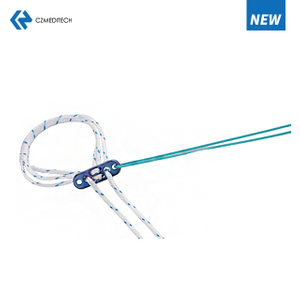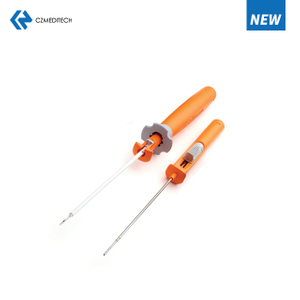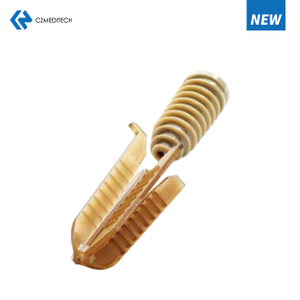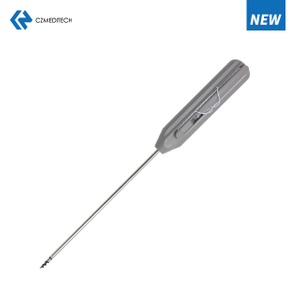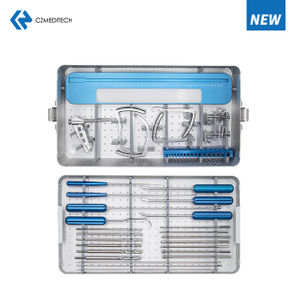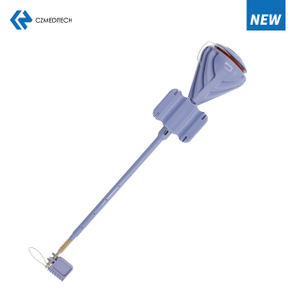Polyethylene Suture
Introduction
Polyethylene sutures have become an indispensable part of modern surgical procedures. But what exactly are they, and why are they so crucial in medical practice? Polyethylene sutures are synthetic, non-absorbable threads used by surgeons to close wounds and surgical incisions. Known for their high tensile strength and flexibility, these sutures have revolutionized the field of surgery.
In this article, we'll delve into the fascinating world of polyethylene sutures. We'll explore their history, composition, and the reasons why they're preferred in various types of surgeries. We'll also look at the advantages they offer, the challenges they pose, and the future prospects of these remarkable medical tools.
History of Polyethylene Sutures
Early Developments in Surgical Sutures
The history of sutures dates back thousands of years. Ancient civilizations used natural materials like silk and catgut for stitching wounds. These materials, while groundbreaking at the time, had significant limitations in terms of strength and durability.
Introduction of Synthetic Sutures
The 20th century saw the advent of synthetic sutures, marking a significant leap forward in surgical technology. Synthetic materials like nylon and polypropylene offered improved strength and reduced infection rates. However, it was the development of polyethylene sutures that truly changed the game.
Evolution and Adoption of Polyethylene Sutures
Polyethylene sutures emerged as a superior option due to their exceptional properties. Initially adopted for specialized surgeries, they soon gained widespread acceptance across various medical fields.
Composition and Properties
Material Composition
Polyethylene sutures are made from high-density polyethylene (HDPE), a thermoplastic polymer known for its robustness. This material provides the sutures with remarkable strength and flexibility.
Key Properties
Strength
One of the standout features of polyethylene sutures is their high tensile strength. This makes them ideal for surgeries where strong wound closure is critical.
Flexibility
Despite their strength, polyethylene sutures are incredibly flexible. This allows for easy handling and manipulation during surgery.
Durability
Polyethylene sutures are non-absorbable, meaning they do not degrade over time. This makes them suitable for long-term applications, especially in areas subjected to constant movement or stress.
Comparison with Other Suture Materials
When compared to other materials like polypropylene and nylon, polyethylene sutures offer a superior combination of strength, flexibility, and biocompatibility. These qualities make them a preferred choice for many surgeons.
Types of Polyethylene Sutures
Monofilament sutures consist of a single strand of polyethylene. They are smooth, reducing tissue drag and minimizing trauma during insertion.
Braided Polyethylene Sutures
Braided sutures are made from multiple strands of polyethylene woven together. They offer enhanced knot security and are easier to handle.
Coated Polyethylene Sutures
Some polyethylene sutures come with a special coating to further reduce tissue drag and enhance biocompatibility. This coating can also make the sutures more resistant to bacterial colonization.
Advantages of Polyethylene Sutures
High Tensile Strength
Polyethylene sutures can withstand significant force without breaking, ensuring reliable wound closure even in high-stress areas.
Biocompatibility
These sutures are well-tolerated by the body, reducing the risk of adverse reactions and infections.
Low Tissue Reaction
Polyethylene sutures cause minimal tissue reaction, promoting faster healing and reducing the risk of inflammation.
Ease of Handling and Knot Security
Surgeons appreciate the ease with which polyethylene sutures can be tied and secured. Their flexibility and smooth surface make knot tying straightforward and reliable.
Applications in Surgery
General Surgery
In general surgery, polyethylene sutures are used for closing incisions, securing tissues, and ligating blood vessels. Their strength and reliability make them a staple in this field.
Orthopedic Surgery
Orthopedic surgeons rely on polyethylene sutures for procedures involving bones and joints. Their durability and flexibility are crucial for these high-stress applications.
Cardiovascular Surgery
In cardiovascular surgery, polyethylene sutures are used to repair blood vessels and heart tissues. Their biocompatibility and strength are particularly valuable in this delicate field.
Ophthalmic Surgery
Ophthalmologists use polyethylene sutures for eye surgeries, where precision and minimal tissue reaction are paramount.
Other Specialized Procedures
Polyethylene sutures are also used in various other specialized procedures, from plastic surgery to neurosurgery, thanks to their versatile properties.
Techniques for Using Polyethylene Sutures
Knot Tying Techniques
Proper knot tying is essential for ensuring the security of polyethylene sutures. Surgeons use various techniques to achieve strong and reliable knots.
Needle Types and Selection
The choice of needle is critical when using polyethylene sutures. Different needle types are selected based on the specific requirements of the surgery.
Suture Placement Strategies
Effective suture placement is key to successful wound closure. Surgeons carefully plan the placement of sutures to ensure optimal healing and minimal scarring.
Comparative Analysis with Other Sutures
Polypropylene Sutures
While similar in many ways, polyethylene sutures offer superior flexibility compared to polypropylene sutures, making them easier to handle.
Nylon Sutures
Nylon sutures are strong and flexible, but they tend to degrade over time. Polyethylene sutures, being non-absorbable, maintain their integrity indefinitely.
Silk Sutures
Silk sutures are soft and easy to handle, but they lack the strength and durability of polyethylene sutures. They are also more prone to causing tissue reactions.
Absorbable vs. Non-Absorbable Sutures
Polyethylene sutures are non-absorbable, making them ideal for long-term applications. Absorbable sutures, on the other hand, are designed to degrade over time and are used for temporary wound closure.
Challenges and Considerations
Cost Implications
Polyethylene sutures tend to be more expensive than other types. However, their benefits often justify the higher cost, especially in complex surgeries.
Training and Skill Requirements
Using polyethylene sutures effectively requires specialized training and skills. Surgeons must be adept at handling these sutures to maximize their benefits.
Potential Complications
While generally safe, polyethylene sutures can sometimes lead to complications such as infection or tissue reaction. Proper surgical techniques and hygiene practices are essential to minimize these risks.
Recent Advances in Polyethylene Sutures
Innovations in Coating Technologies
New coating technologies are enhancing the properties of polyethylene sutures, making them even more biocompatible and resistant to bacterial colonization.
Enhancements in Biocompatibility
Ongoing research is focused on improving the biocompatibility of polyethylene sutures, reducing the risk of adverse reactions.
Integration with Advanced Surgical Techniques
Polyethylene sutures are increasingly being integrated with advanced surgical techniques, such as minimally invasive and robotic surgeries, to enhance their effectiveness.
Environmental and Ethical Considerations
Sustainability in Production
Efforts are being made to produce polyethylene sutures more sustainably, reducing their environmental impact.
Disposal and Environmental Impact
Proper disposal of polyethylene sutures is crucial to minimize their environmental footprint. Hospitals are adopting better waste management practices to address this issue.
Ethical Sourcing of Materials
Ensuring that the raw materials for polyethylene sutures are sourced ethically is an important consideration for manufacturers and healthcare providers.
Future Prospects
Emerging Trends in Suture Technologies
The field of suture technology is continuously evolving, with new materials and techniques being developed to improve surgical outcomes.
Potential Improvements and Innovations
Future innovations may include biodegradable polyethylene sutures and smart sutures that can monitor wound healing and deliver medication.
The Future of Polyethylene Sutures in Medicine
Polyethylene sutures are likely to remain a cornerstone of surgical practice, thanks to their unmatched properties and ongoing advancements.
Conclusion
Polyethylene sutures have revolutionized the field of surgery with their exceptional strength, flexibility, and biocompatibility. They play a critical role in a wide range of surgical procedures, from general surgery to specialized fields like ophthalmology and cardiovascular surgery. As technology advances, we can expect even more innovations that will enhance the performance and applications of these remarkable sutures.
FAQs
Polyethylene sutures offer high tensile strength, biocompatibility, low tissue reaction, and ease of handling, making them ideal for a wide range of surgical procedures.
How do polyethylene sutures compare to other synthetic sutures?
Compared to other synthetic sutures like polypropylene and nylon, polyethylene sutures provide a superior combination of strength, flexibility, and biocompatibility.
Are there any risks associated with using polyethylene sutures?
While generally safe, polyethylene sutures can sometimes lead to complications such as infection or tissue reaction. Proper surgical techniques and hygiene practices are essential to minimize these risks.
What advancements are expected in the field of polyethylene sutures?
Future advancements may include innovations in coating technologies, enhancements in biocompatibility, and the development of smart sutures that monitor wound healing and deliver medication.
How do surgeons decide which type of suture to use?
Surgeons choose sutures based on factors such as the type of surgery, the tissue being sutured, the required strength and flexibility, and the patient's specific needs.


















